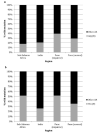Genetic attributes of blood-derived subtype-C HIV-1 tat and env in India and neurocognitive function
- PMID: 24150902
- PMCID: PMC3872113
- DOI: 10.1002/jmv.23816
Genetic attributes of blood-derived subtype-C HIV-1 tat and env in India and neurocognitive function
Abstract
Genetic elements in HIV-1 subtype B tat and env are associated with neurotoxicity yet less is known about other subtypes. HIV-1 subtype C tat and env sequences were analyzed to determine viral genetic elements associated with neurocognitive impairment in a large Indian cohort. Population-based sequences of HIV-1 tat (exon 1) and env (C2-V3 coding region) were generated from blood plasma of HIV-infected patients in Pune, India. Participants were classified as cognitively normal or impaired based on neuropsychological assessment. Tests for signature residues, positive and negative selection, entropy, and ambiguous bases were performed using tools available through Los Alamos National Laboratory (http://www.hiv.lanl.gov) and Datamonkey (http://www.datamonkey.org). HIV-1 subtype C tat and env sequences were analyzed for 155 and 160 participants, of which 34-36% were impaired. Two signature residues were unique to impaired participants in exon 1 of tat at codons 29 (arginine) and 68 (proline). Positive selection was noted at codon 29 among normal participants and at codon 68 in both groups. The signature at codon 29 was also a signature for low CD4+ (<200 cells/mm(3)) counts but remained associated with impairment after exclusion of those with low CD4+ counts. No unique genetic signatures were noted in env. In conclusion, two signature residues were identified in exon 1 of HIV-1 subtype C tat that were associated with neurocognitive impairment in India and not completely accounted for by HIV disease progression. These signatures support a linkage between diversifying selection in HIV-1 subtype C tat and neurocognitive impairment.
Keywords: clade C; impairment; neuropsychological testing; residue; sequence; signature.
© 2013 Wiley Periodicals, Inc.
Figures


Similar articles
-
HIV-1 subtype C Tat exon-1 amino acid residue 24K is a signature for neurocognitive impairment.J Neurovirol. 2022 Jun;28(3):392-403. doi: 10.1007/s13365-022-01073-4. Epub 2022 Apr 8. J Neurovirol. 2022. PMID: 35394614
-
Clade C HIV-1 isolates circulating in Southern Africa exhibit a greater frequency of dicysteine motif-containing Tat variants than those in Southeast Asia and cause increased neurovirulence.Retrovirology. 2013 Jun 8;10:61. doi: 10.1186/1742-4690-10-61. Retrovirology. 2013. PMID: 23758766 Free PMC article.
-
Genetic features of cerebrospinal fluid-derived subtype B HIV-1 tat.J Neurovirol. 2012 Apr;18(2):81-90. doi: 10.1007/s13365-011-0059-9. Epub 2012 Apr 13. J Neurovirol. 2012. PMID: 22528397 Free PMC article.
-
Functional impact of HIV-1 Tat on cells of the CNS and its role in HAND.Cell Mol Life Sci. 2020 Dec;77(24):5079-5099. doi: 10.1007/s00018-020-03561-4. Epub 2020 Jun 23. Cell Mol Life Sci. 2020. PMID: 32577796 Free PMC article. Review.
-
Genetic variation and HIV-associated neurologic disease.Adv Virus Res. 2013;87:183-240. doi: 10.1016/B978-0-12-407698-3.00006-5. Adv Virus Res. 2013. PMID: 23809924 Free PMC article. Review.
Cited by
-
Impact of the HIV Tat C30C31S dicysteine substitution on neuropsychological function in patients with clade C disease.J Neurovirol. 2014 Dec;20(6):627-35. doi: 10.1007/s13365-014-0293-z. Epub 2014 Nov 1. J Neurovirol. 2014. PMID: 25366660 Free PMC article.
-
Attention/Working Memory, Learning and Memory in Adult Cameroonians: Normative Data, Effects of HIV Infection and Viral Genotype.J Int Neuropsychol Soc. 2020 Jul;26(6):607-623. doi: 10.1017/S1355617720000120. Epub 2020 Feb 18. J Int Neuropsychol Soc. 2020. PMID: 32066518 Free PMC article.
-
HIV-1 subtype C Tat exon-1 amino acid residue 24K is a signature for neurocognitive impairment.J Neurovirol. 2022 Jun;28(3):392-403. doi: 10.1007/s13365-022-01073-4. Epub 2022 Apr 8. J Neurovirol. 2022. PMID: 35394614
References
-
- Antinori A, Arendt G, Becker JT, Brew BJ, Byrd DA, Cherner M, Clifford DB, Cinque P, Epstein LG, Goodkin K, Gisslen M, Grant I, Heaton RK, Joseph J, Marder K, Marra CM, McArthur JC, Nunn M, Price RW, Pulliam L, Robertson KR, Sacktor N, Valcour V, Wojna VE. Updated research nosology for HIV-associated neurocognitive disorders. Neurology. 2007;69:1789–1799. - PMC - PubMed
-
- Carey CL, Woods SP, Gonzalez R, Conover E, Marcotte TD, Grant I, Heaton RK. Predictive validity of global deficit scores in detecting neuropsychological impairment in HIV infection. J Clin Exp Neuropsychol. 2004;26:307–319. - PubMed
-
- Choi JY, Hightower GK, Wong JK, Heaton R, Woods S, Grant I, Marcotte TD, Ellis RJ, Letendre SL, Collier AC, Marra CM, Clifford DB, Gelman BB, McArthur JC, Morgello S, Simpson DM, McCutchan JA, Richman DD, Smith DM. Genetic features of cerebrospinal fluid-derived subtype B HIV-1 tat. J Neurovirol. 2012;18:81–90. - PMC - PubMed
Publication types
MeSH terms
Substances
Grants and funding
- K24 AI100665/AI/NIAID NIH HHS/United States
- R01 AI047745/AI/NIAID NIH HHS/United States
- AI36214/AI/NIAID NIH HHS/United States
- AI47745./AI/NIAID NIH HHS/United States
- DP1 DA034978/DA/NIDA NIH HHS/United States
- R56 AI047745/AI/NIAID NIH HHS/United States
- MH62512/MH/NIMH NIH HHS/United States
- R01 MH083552/MH/NIMH NIH HHS/United States
- R01 MH097520/MH/NIMH NIH HHS/United States
- R01 MH078748/MH/NIMH NIH HHS/United States
- R01; MH78748/MH/NIMH NIH HHS/United States
- MH83552/MH/NIMH NIH HHS/United States
- MH097520/MH/NIMH NIH HHS/United States
- R21 AI047745/AI/NIAID NIH HHS/United States
- DA034978/DA/NIDA NIH HHS/United States
- P30 MH062512/MH/NIMH NIH HHS/United States
- P30 AI036214/AI/NIAID NIH HHS/United States
- AI100665/AI/NIAID NIH HHS/United States
LinkOut - more resources
Full Text Sources
Other Literature Sources
Medical
Research Materials
Miscellaneous

